BibTeX | RIS | EndNote | Medlars | ProCite | Reference Manager | RefWorks
Send citation to:
URL: http://johe.rums.ac.ir/article-1-189-en.html
Google Scholar
2- Dept. of Radiology, Faculty of Para Medicine, Hamadan University of Medical Sciences, Hamadan, Iran. ,
3- Dept. of Radiology, Hamedan University of Medical Sciences, Hamadan, Iran
4- Dept of Biostatistics & Epidemiology, School of Public Health, Hamadan University of Medical Sciences, Hamadan, Iran.

Accepted: 2015/12/6
ePublished: 2016/03/16
Background: The biological effects of radiation on radiology personnel are divided into two groups of deterministic effects and stochastic effects. Due to the effects of radiation on health, radiology staff may be afraid of radiation. Younger personnel with little work experience, compared with older personnel, have higher level of fear. The fear among radiology personnel, like employees of various departments, can impact their job satisfaction and performance.
Materials and Methods: This descriptive, cross-sectional research was performed on radiology staff of hospitals affiliated with Hamadan University of Medical Sciences, Iran, in the year 2014. In total, 70 questionnaires were distributed among the radiology personnel of these hospitals, of which 49 questionnaires were completed. This questionnaire consisting of 14 questions scored on a 5-point Likert scale ranging from 1-5 (from very high to very low). All P-values of more than 0.05 (P > 0.05) were considered significant.
Results: No significant relationship was observed between fear of radiation and education, age, gender, marital status, and work experience.
Conclusions: The total mean for very low level of fear of radiation among the radiology staff of hospitals affiliated to Hamadan University of Medical Sciences was 15.73%. Furthermore, no significant relationship was observed between fear and other variables such as education, age, gender, marital status, and work experience (P > 0.05).
| Rights and permissions | |
 |
This work is licensed under a Creative Commons Attribution 4.0 International License. |






